December, 1998
Field Crops 28.31-19
Management Needs for Specialty Corn Hybrids
Joe Lauer, Corn Agronomist
Due to recent premiums offered by end-users and the dramatic adoption by farmers
of genetically engineered hybrids, specialty corns are receiving more attention
as potentially profitable alternatives to yellow dent corn. Specialty corns can
be divided into two major groups involving marketing and management. Specialty corns
are genetic modifications of yellow dent corn normally grown for grain. Traditionally
corn has been treated, handled and marketed as a bulk commodity. Corn grain users
and processors have become more interested in the quality characteristics of corn
grain and how quality affects their business. Plant breeders have altered the starch,
protein and oil content of corn to better meet the needs of the livestock feeder,
the food industry, and industrial users of corn. Corn that meets specific user needs
are called value-added or identity preserved (IP) grains.our "toolbox"
for fighting pests are the development of genetically engineered corns. These hybrids
protect yield and may require farmers to reexamine traditional management and production
principles.
SPECIALTY MARKET CORNS
There is a diverse group of specialty market corns produced in Wisconsin. Contracts
for growing specialty corns usually offer a premium over the yellow dent price to
compensate for the lower yield potential and special handling required for ensuring
high grain quality.
WAXY CORN is a starch variant of normal corn caused by a single recessive gene.
Waxy corn contains the values added trait of 100 percent amylopectin whereas normal
corn contains 75 percent amylopectin and 25 percent amylose. Amylopectin is a form
of starch that consists of branched glucose chains while amylose is made up of unbranched
glucose molecules. Waxy corn is processed in wet milling to produce waxy cornstarch
which retrogrades back to the crystalline form of starch slowly. It is used by the
food industry as a stabilizer/thickener and in the paper industry as an adhesive.
Waxy corn for wet milling is usually grown under contract for wet-corn millers or
exporters, with premiums ranging from $0.15 to $0.20. It is also grown by livestock
producers, but feeding results have been inconsistent (either no change or slightly
positive) compared to normal dent corn. Current U.S. production is about 80 million
bushels on 700,000 acres with most of the production in Nebraska, Illinois, Minnesota,
and Indiana. Waxy corn is developed by converting standard commercial hybrids so
performance tends to lag behind. Under weather stress conditions waxy corn can yield
less than normal corn.
HIGH-AMYLOSE CORN (AMYLOMAIZE) is a starch variant of corn caused by a single recessive
gene. It has an amylose content between 55 and 80 percent and is grown exclusively
for wet-milling to produce a starch that crystallizes quickly. The starch from high-amylose
corn is used in textiles, candies, adhesives and other environmentally "friendly"
products like Eco-foam packaging materials. Total U.S. acreage is estimated at 35,000
acres mostly contracted in Illinois, Indiana and Kentucky on a per acre basis.
HIGH-OIL CORN contains more than 6 percent oil on a dry weight basis. This is 2
to 3 percent higher than normal corn. The oil is an enhanced source of corn oil
in margarine and cooking oils and has increased energy per unit of feed, which is
important in monogastric animals. Additionally, protein quality and quantity are
increased in high-oil corn because the germ size is larger. High-oil corn is used
primarily as an animal feed because it has greater energy per unit volume than normal
corn. Premiums for high-oil corn are $0.10 per bushel per point of oil between 6
and 7.5 percent oil content. The TOPCROSS® grain production system licensed by DuPont
Quality Grains is rapidly gaining popularity as the preferred method for producing
high-oil corn. Current U.S. production is nearly 1 million acres. The TOPCROSS®
grain production system is a mechanical mixture of two types of corn seed. One type,
representing 90 to 95 percent of the seed in a bag, is a hybrid that is designated
as the "Grain Parent." The normal male fertile version is called the "Grain
Parent Check." The second type, representing all remaining seed, is a special
"Pollinator." The Grain Parent is a male sterile version of an elite hybrid
that may already be in commercial production. The Pollinator is a special line,
available from DuPont and licensed to the seed company, that sheds pollen within
a TOPCROSS® production field. The pollen shed from these Pollinator plants contain
special genes that cause a kernel to produce a much larger than average germ or
embryo (commonly called xenia effect). Since most of the oil and protein
is in the germ, the oil, and thus the energy level, and protein quality of the grain
produced by fertilization with these pollinators is enhanced. The hybrids blended
to produce the TOPCROSS® high oil grain are designated TC-BLEND® seed products and
cost $20 to $30 more per unit than normal dent corn. Pollinator plants contribute
little to overall grain yield, but use resources such as soil nutrients, water and
sunlight. Their function is to provide pollen to the male sterile Grain Parent.
TOPCROSS® fields must be somewhat isolated from other "wild" corn pollen
sources because wild pollen will not transfer the high-oil trait. Standard seed
production procedures require that corn fields must be isolated by 660 feet from
the nearest corn field. Most pollen from a plant usually falls within 50 to 100
feet of the plant. Key problems include: reduced grain yield in the range of 5 to
20% depending upon the type of hybrid pollination system used, increased moisture
content at harvest, and environment influences on total oil content and yield.
HIGH-LYSINE CORN involves the major genes: opaque-2 and floury-2. Current production
is about 35 million bushels on 300,000 acres. The value-added traits are an increase
in lysine and tryptophan, and a decrease in leucine, thus a nutritionally better
balance of amino acids for monogastric animals. Its primary uses are as a livestock
feed. Key problems include reduced grain yields in the range of 10 to 15 percent,
an unacceptable kernel phenotype for processing due to increased grain moisture
at harvest and greater susceptibility to kernel breakage (soft, chalky endosperm).
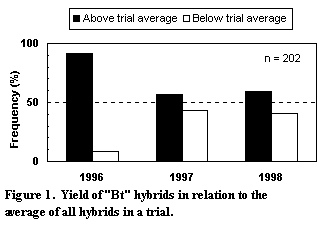
WHITE AND YELLOW FOOD CORNS are caused by a single recessive gene controlling white
and yellow color. Current U.S. acreage of white corn is 600,000 acres, while yellow
corn accounts for one million acres. Premiums paid to farmers for yellow food corn
range from $0.05 to $0.15 per bushel with lower and higher premiums going to yellow
food grade corn produced on red versus white cobs. White and yellow food corns are
typically contracted and sold to dry-mill processors and used in breakfast cereals,
snack chips, and grits. Food grain corns have been selected for specific kernel
characteristics that are important for the production of alkaline-cooked products
such as snack and Mexican-type foods. Specific quality traits for alkaline-processed
foods include ease and completeness of pericarp removal, hardness of endosperm,
kernel crown configuration, uniform sized kernels, high specific gravity, kernel
red streak resistance, and a white cob. White corn contains a similar amount of
carbohydrates as yellow corn but is deficient in vitamin A (carotene). White corn
yield tend to yield less than normal yellow corn and was considered more susceptible
to drought and other stresses than yellow corn. Other colored corns marketed and
sold include green corn and blue corn. Key problems especially for white corn is
that isolation is required. The endosperm must be devoid of all pigments, have a
clear aleurone and percicarp, and a non-pigmented embryo and scutellum. It must
also have a white cob and produce a large uniform kernel, with no dent, and no stress
cracks.
SILAGE CORN traits involve quantitative genes. Although a few types, like bmr
corn are controlled by single genes. Current U.S. silage production is on 6 to 7
million acres (~ 8 % of corn acreage) and Wisconsin is the leading corn silage producing
state. Value-added traits of corn silage hybrids increase animal performance through
lower fiber (greater intake) and higher digestibility (high energy). A key problem
is that it must be fed on or near farm where it is produced.
HIGH AVAILABLE PHOSPHOROUS / LOW PHYTATE ("HAP") CORN is caused by a single
gene. There is no current production in the U.S. Its value-added trait is that phosphorous
is stored in the grain in a more readily available form for monogastric animals.
This may cause less environmental problems associated with pollution from manure
and less mineral supplementation because phytic acid chelates with minerals. Key
problems include reduced grain yield: 10 to 20% yield reductions compared to normal
corn.
SWEET AND POP CORN are usually produced under contract with a processor. Wisconsin
is a leading state in sweet corn production.
SPECIALTY MANAGEMENT CORNS
Various specialty management hybrids may also be considered value added because
they offer an economic benefit to farmers. Use of these hybrids may help growers
improve weed and insect control in corn as well as reduce costs of pesticide applications.
Specialty corns work. Corn hybrid traits are usually expressed the way they are
designed but often at a yield cost compared to normal hybrids. This "yield
drag" or "yield lag" as it has been called by farmers is a major
obstacle limiting production of several specialty corns. Several factors have contributed
to lower yields in specialty corns. The conversion of normal corn to a specialty
hybrid requires numerous cycles of back-crossing. The time that is required to complete
the back-cross process has resulted in specialty hybrids to lag behind that of the
normal hybrid from which it is derived. Second the conversion of normal hybrids
is not always "clean." Sometimes undesirable agronomic characteristics
are strongly linked to the gene that conferred the specialty trait and this "linkage"
decreases yield performance. The concept of yield drag and yield lag is real and
as plant breeders spend more time and resources making sure that specialty traits
work, it will come at a cost and yield progress will likely be slowed. Finally,
yield performance variability exists among specialty hybrids.
BT CORN is an abbreviation for the bacteria, Bacillus thuringiensis, which
is found in the soil. Bt forms a crystal protein that is toxic to caterpillars (lepidopterans),
beetles (e.g. corn rootworm and Colorado potato beetle), and aquatic flies (e.g.
black flies and mosquitoes). After the insect eats Bt, the crystal dissolves to
release a toxin that attacks the gut lining. Feeding stops within a few hours. The
insect gut wall breaks down within 24 hours. Bacterial spores germinate and invade
the body cavity of the insect. The insect dies from toxins attacking the gut wall,
by a general body infection (septicemia) which is present within 48 hours, and food
deprivation. Over 70 different toxins are formed from Bt crystal proteins. The activity
of the toxin in an insect depends on gut pH, the presence of enzymes and reducing
agents, and the presence of binding sites on cell membranes. Production of the Bt
protein in corn continues as long as the corn is actively growing and declines after
ear fill begins. Different plant parts will express differing levels of the Bt protein
(Table 1). A number of questions need to be addressed regarding long term economics,
since European Corn Borer outbreaks do not occur every year. In addition, special
resistance management strategies may need to be developed. Bt hybrid corn performance
in Wisconsin trials has typically been better than normal dent corn in all years
(Figure 1). Performance has been better than normal dent corn regardless of the
amount of European corn borer pressure. In 1996 ECB pressure was greater than normal,
while in 1998, ECB pressure was mostly absent. Bt hybrids more frequently beat the
trial average than normal dent corn.

IMI CORN ("IT/IR") is resistant or tolerant to imidazolinone family of
herbicides (Pursuit and Scepter) due to a single semi-dominant allele. To produce
IT corn inbreds, corn with the IT allele is back-crossed to a recurrent inbred parent.
Hybrid corn is sold as IT or IR. IT hybrids have the gene from one inbred parent,
while IR hybrids have the tolerant gene from both inbred parents. Scientists at
American Cyanamid Company discovered the imidazolinone herbicides in the 1970's.
In 1982, American Cyanamid began collaborating with Molecular Genetics, Inc. to
develop imidazolinone tolerant corn. By 1984, Molecular Genetics, Inc. had successfully
regenerated corn with imidazolinone tolerant (IT) genes which then allowed back-crossing
to inbred lines. In 1992, the first corn hybrids were produced for commercial sale.
These hybrids had a 2X to 4X crop safety level compared to imidazolinone herbicides.
In 1993, Pursuit (imazethapyr) herbicide was labeled for use in corn. IMI corn may
be good insurance where herbicide carryover is suspected. American Cyanamid is promoting
the use of IMI corn hybrids with corn hybrid post-emergence treatments of Pursuit
to control small annual grasses and broadleaf weeds. Since Pursuit may be weak on
ragweeds, lambsquarters, perennials, large grass, and drought stressed weeds; American
Cyanamid is promoting the use of Resolve, a premix of Pursuit and Banvel to improve
control of some weeds. Numerous IMI hybrids with a wide range of maturity are available.
Good progress has been seen since 1992 (Figure 2). In 1998, the IMI hybrids yielded
above the trial mean about 33% of the time.
SR CORN is resistant to broadcast applications of Poast, sethoxydim. BASF is promoting
the use of SR corn for post-emergence annual grass control in corn. SR corn performance
has been similar to IMI corn progress (Figure 3). Initially, SR hybrids yielded
less than the trial average more frequently than normal dent corn. In 1998, SR performance
was similar to regular dent corn.
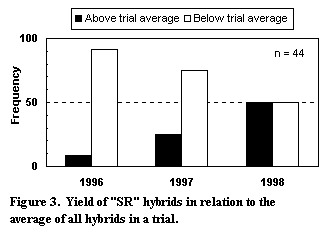
LIBERTY LINK CORN is tolerant to broadcast applications of Liberty herbicide, glufosinate
ammonium. The gene that gives resistance to glufosinate came from a naturally occurring
soil bacterium, Streptomycin hygroscopicus. Glufosinate is a fast acting,
post-emergent, foliar applied, non-selective contact herbicide that controls a broad
spectrum of weeds. It has no translocation or root uptake. AgrEvo is promoting the
use of Liberty Link hybrids with Liberty for broadcast control of annual weeds and
suppression of perennials. It is most effective on small weeds but less effective
on lambsquarters, drought stressed velvetleaf and large annual grasses. Liberty
Link hybrid performance has been somewhat inconsistent in the trials (Figure 4).
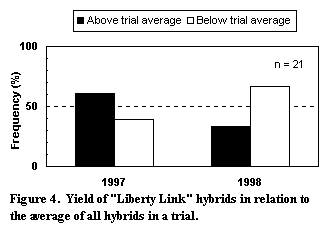
ROUND-UP READY CORN is resistant to the herbicide glyphosate, a post-emergent, foliar
applied, non-selective herbicide that controls a broad spectrum of weeds. It was
first made available to farmers commercially in 1998 (Figure 5). It is still too
early to evaluate market acceptance and yield potential.
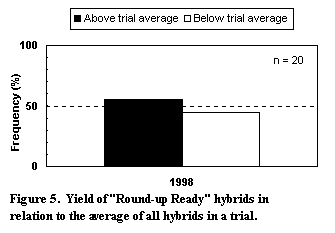
GENE STACKED CORN is the marketing name given to hybrids with more than one gene
derived from genetically engineered methods. Currently, the only hybrids available
include the Bt and Liberty Link technologies. It is still too early to evaluate
market acceptance and yield potential (Figure 6).
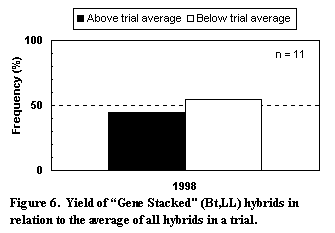
MANAGEMENT NEEDS OF SPECIALTY CORNS
The cultural practices that are required for successful specialty corn production
are similar to those used to optimize performance of normal yellow dent corns. For
specialty market corns management practices that preserve grain identity from planting
through storage need to be followed. Growers should follow recommended agronomic
practices, including the maintenance of good soil fertility and pest control to
minimize stress and maximize yield potential.
The following are some key management practices when producing specialty market
corns.
- Select fields with high yield potential. Usually specialty corn seed is more expensive.
Plant specialty corns on the most fertile well-drained soils to maximize yield and
reduce stress. Avoid droughty and poorly drained soil conditions.
- Use crop rotations. For best results plant specialty corn hybrids after soybean
or forage legumes. Grain yields of rotated corn will typically be about 10% higher
than corn following corn. This yield advantage is much more pronounced when stress
occurs during the growing season. Another benefit of rotated corn is less pest pressure.
Rotated corn will also minimize volunteer corn, which can cause contamination problems
during pollination in waxy, high-oil, high-lysine and high amylose corn
- Isolate specialty corns from normal yellow dent corn. Fields planted to waxy, high-lysine,
high-oil and high amylose corn need to be isolated to minimize cross pollination.
- Select specialty hybrids adapted to your growing conditions. Chose the specialty
hybrid best suited to your farming system. The decision should be based on yield
potential and stability, maturity, lodging resistance, and pest resistance. Prepare
a seedbed that will promote uniform seed emergence and crop development.
- Prepare a seedbed that will promote uniform seed emergence and crop development.
Soil crusting or cool weather could have different effects on emergence and stand
establishment of high-oil corn blends.
- Follow recommended seeding rates. Specialty hybrids require different optimum seeding
rates. For example, high-oil corn population recommendations are usually about 2,000
plants per acre greater than normal corn.
- Plant on optimum planting dates to optimize grain yield. Planting early will help
extend the grain filling period and reduce the likelihood of stress during pollination.
However, avoid wet, cold soils that may cause emergence problems.
- Scout fields regularly for potential pest problems.
- Segregate specialty corns to preserve its "identity" and maximize oil
premiums. Store specialty market hybrids in separate bins to prevent mixing with
normal corn.
|
Table 1. Bt corn registrations as of December, 1998
|
|
Company
|
Event
|
Protein
|
Brand
|
1st ECB 2nd ECB
|
Refugia
|
|
Novartis
|
176
|
CryIA(b)
|
Knockout / Maximizer
|
Yes
|
No
|
Suggested
|
|
Mycogen
|
176
|
CryIA(b)
|
NatureGard
|
Yes
|
No
|
Suggested
|
|
Monsanto
|
Bt11
|
CryIA(b)
|
YieldGard
|
Yes
|
Yes
|
Suggested
|
|
Monsanto
|
MON810
|
CryIA(b)
|
YieldGard *
|
Yes
|
Yes
|
Agreement 5% acres
|
|
DeKalb
|
DBT418
|
CryIA(c)
|
Bt-Xtra
|
Yes
|
Limited
|
5% acres
|
|
PGS/AgrEvo
|
CBH351
|
Cry9(c)
|
StarLink
|
Yes
|
Yes
|
5% acres
|
|
* Supplemental distributors: Cargill, DeKalb, Golden Harvest, ICI/Garst, and Pioneer
|